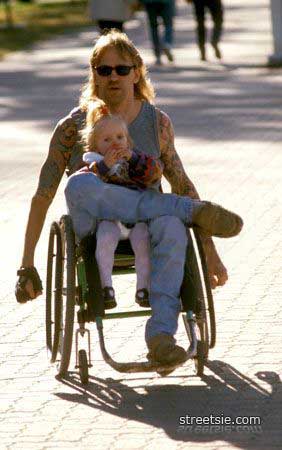Well, sort of. I mean, an ADA compliant business can't simply make an arbitrary decision and then say it's for everyone's safety. Consider non-conventional mobility aids like Segways or ECVs powered by combustion engines. If a business is open to the public, they may not deny a disabled person the right to use their prefered mobility device...
As an example...
These citations come from this document
https://www.ada.gov/opdmd.pdf and relate to the rules allowing for use of Segways and Other Power-Driven Mobility Devices (OPDMD). But look at the language and see how the ADA looks at accommodation of a disability.
The disabled person gets what he or she needs to live their life as normally as possible unless that choice poses a
significant and
immediate risk to safety or the surrounding facilities. You cannot simply name off some blanket rule followed by the empty headed "rules are rules", and still remain ADA compliant.
A woman, sitting on her own parked ECV, nursing her child, is not putting anything or anyone at a significant risk. That same woman, with her infant in a baby bjorn, cruising her ECV down Mainstreet USA at a normal walking pace is of no more risk than an able legged mother (or father) doing the same thing.
The law is clear. You may not single someone out with harder standards based solely on the technology they need to live a normal life. If you want to tell a person they may not do something (that they need to do because of a disability) because you believe it to be unsafe, then you have to show how this specific person doing this specific activity created this significant and immediate risk.
As I mentioned, this can sometimes be easier than others. An ambulatory child riding their quad-father creates a risk that the control device may become jarred or the operator's vision may become obstructed in a way he is unable to remedy himself.
But as a general policy each case must be appreciated separately, because, just like the rest of us, mobility challenged people are individuals.
*Note* I should also point out that WDW may have a greater right to discriminate against the disabled than the ADA brief I linked suggests. It specifies "covered entities" (meaning those places covered by the new ruling) as state and local governments and non-profits and businesses that serve the public. Even though Disney has argued before that each day in the parks is a ticketed event and not the same as serving the public, they were still held to this same level of scrutiny in Baughman v. Walt Disney World Company, a case demanding ADA accommodation for those using Segways as mobility aids. Baughman lost her case, for failing to provide expert testimony that Segway usage by the disabled could be done safely in the parks. I wish she had known me. I can demonstrate a stand-up mobility platform that can 'run' through crowds faster and safer than a person on foot.
